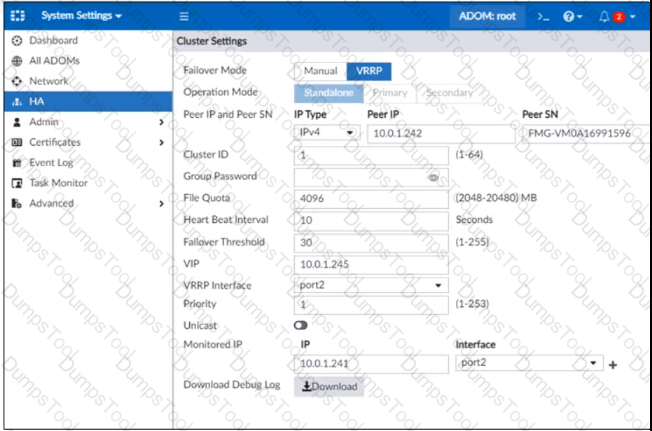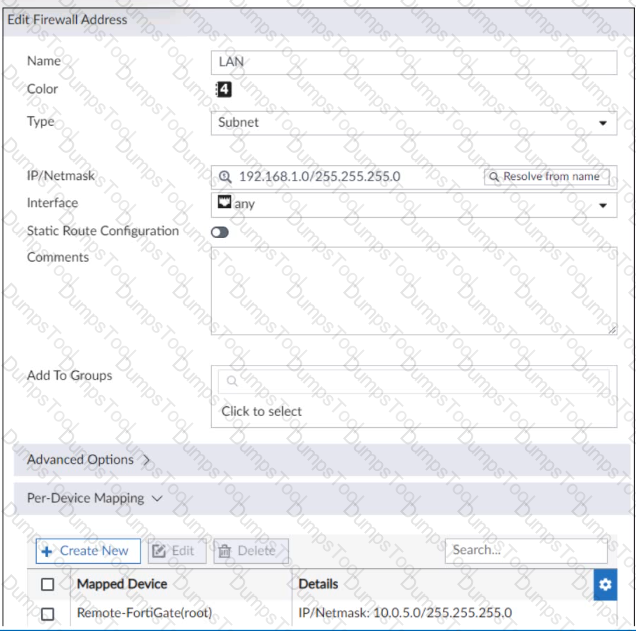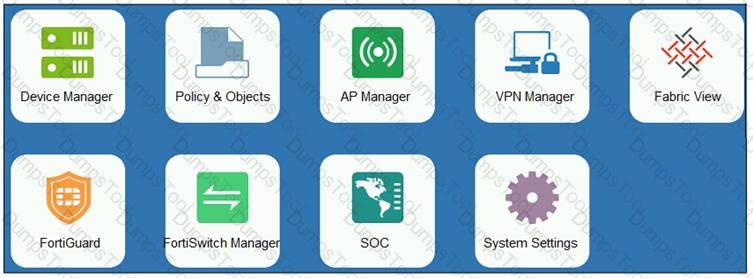View the following exhibit.

Which one of the following statements is true regarding the object named ALL?
Which three settings are the factory default settings on FortiManager? (Choose three.)
Which of the following statements are true regarding VPN Gateway configuration in VPN Manager? (Choose two.)
Refer to the exhibit.

In the event that the monitored interface for the primary FortiManager device fails, which statement is true about FortiManager HA?
An administrator is replacing a failed device on FortiManager by running the following command:
execute device replace sn
Which device name and serial number must the administrator use?
An administrator has enabled Service Access on FortiManager. What is the purpose of Service Access on the FortiManager interface?
Refer to the exhibit.

An administrator has created a firewall address object that is used in multiple policy packages for multiple FortiGate devices in an ADOM.
After the installation operation is performed, which IP/netmask will be shown on FortiManager for this firewall address object without specify Per-Device Mapping?
Refer to the exhibit.

An administrator wants to create a policy on the Staging ADOM in backup mode, and install it on the FortiGate device in the same ADOM.
How can the administrator perform this task?
In addition to the default ADOMs, an administrator has created a new ADOM named Training for FortiGate devices. The administrator authorized the FortiGate device on FortiManager using the Fortinet Security Fabric.
Given the administrator's actions, which statement correctly describes the expected result?
An administrator would like to authorize a newly-installed AP using AP Manager. What steps does the administrator need to perform to authorize an AP?
Which configuration setting for FortiGate is part of a device-level database on FortiManager?
An administrator with the Super_User profile is unable to log in to FortiManager because of an authentication failure message.
Which troubleshooting step should you take to resolve the issue?
An administrator would like to review, approve, or reject all the firewall policy changes made by the junior
administrators.
How should the Workspace mode be configured on FortiManager?
An administrator has assigned a global policy package to a new ADOM called ADOM1. What will happen if the administrator tries to create a new policy package in ADOM1?
In the event that the primary FortiManager fails, which of the following actions must be performed to return the FortiManager HA to a working state?
Refer to the following exhibit:

Which of the following statements are true based on this configuration? (Choose two.)
An administrator, Trainer, who is assigned the Super_User profile, is trying to approve a workflow session that was submitted by another administrator, Student. However, Trainer is unable to approve the workflow session.
What can prevent an admin account that has Super_User rights over the device from approving a workflow session?

An administrator is replacing a device on FortiManager by running the following command:
execute device replace sn
What device name and serial number must the administrator use?
Which two statements regarding device management on FortiManager are true? (Choose two.)
An administrator configures a new firewall policy on FortiManager and has not yet pushed the changes to the
managed FortiGate.
In which database will the configuration be saved?
Refer to the exhibit.

An administrator logs into the FortiManager GUI and sees the panes shown in the exhibit.
Which two reasons can explain why the FortiAnalyzer feature panes do not appear? (Choose two.)